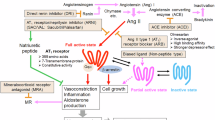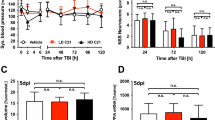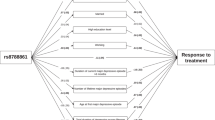Abstract
Long-term pretreatment with an angiotensin II AT1 antagonist blocks angiotensin II effects in brain and peripheral organs and abolishes the sympathoadrenal and hypothalamic–pituitary–adrenal responses to isolation stress. We determined whether AT1 receptors were also important for the stress response of higher regulatory centers. We studied angiotensin II and corticotropin-releasing factor (CRF) receptors and benzodiazepine binding sites in brains of Wistar Hannover rats. Animals were pretreated for 13 days with vehicle or a central and peripheral AT1 antagonist (candesartan, 0.5 mg/kg/day) via osmotic minipumps followed by 24 h of isolation in metabolic cages, or kept grouped throughout the study (grouped controls). In another study, we determined the influence of a similar treatment with candesartan on performance in an elevated plus-maze. AT1 receptor blockade prevented the isolation-induced increase in brain AT1 receptors and decrease in AT2 binding in the locus coeruleus. AT1 receptor antagonism also prevented the increase in tyrosine hydroxylase mRNA in the locus coeruleus. Pretreatment with the AT1 receptor antagonist completely prevented the decrease in cortical CRF1 receptor and benzodiazepine binding produced by isolation stress. In addition, pretreatment with candesartan increased the time spent in and the number of entries to open arms of the elevated plus-maze, measure of decreased anxiety. Our results implicate a modulation of upstream neurotransmission processes regulating cortical CRF1 receptors and the GABAA complex as molecular mechanisms responsible for the anti-anxiety effect of centrally acting AT1 receptor antagonists. We propose that AT1 receptor antagonists can be considered as compounds with possible therapeutic anti-stress and anti-anxiety properties.
Similar content being viewed by others
Log in or create a free account to read this content
Gain free access to this article, as well as selected content from this journal and more on nature.com
or
References
Aguilera G, Kiss A, Luo X (1995a). Increased expression of type 1 angiotensin II receptors in the hypothalamic paraventricular nucleus following stress and glucocorticoid administration. J Neuroendocrinol 7: 775–783.
Aguilera G, Young WS, Kiss A, Bathia A (1995b). Direct regulation of hypothalamic corticotropin-releasing-hormone neurons by angiotensin II. Neuroendocrinology 61: 437–444.
Anderson SM, Kant GJ, De Souza EB (1993). Effects of chronic stress on anterior pituitary and brain corticotropin-releasing factor receptors. Pharmacol Biochem Behav 44: 755–761.
Armando I, Carranza A, Nishimura Y, Hoe KL, Barontini M, Terrón JA et al (2001). Peripheral administration of an angiotensin II AT1 receptor antagonist decreases the hypothalamic–pituitary–adrenal response to stress. Endocrinology 142: 3880–3889.
Armando I, Terrón JA, Falcón-Neri A, Ito T, Häuser W, Inagami T et al (2002). Increased angiotensin II AT1 receptor expression in paraventricular nucleus and hypothalamic–pituitary–adrenal axis stimulation in AT2 receptor gene-disrupted mice. Neuroendocrinology 76: 137–147.
Barnes NM, Costall B, Kelly ME, Murphy DA, Naylor RJ (1990). Anxiolytic-like action of DuP753, a non-peptide angiotensin II receptor antagonist. Neuroreport 1: 20–21.
Berridge CW, Waterhouse BD (2003). The locus coeruleus-noradrenergic system: modulation of behavioral state and state-dependent cognitive processes. Brain Res Rev 42: 33–84.
Biggio G, Concas A, Corda MG, Giorgi O, Sanna E, Serra M (1990). GABAergic and dopaminergic transmission in the rat cerebral cortex: effects of stress, anxiolytic and anxiogenic drugs. Pharmacol Ther 48: 121–142.
Bittencourt JC, Sawchenko PE (2000). Do centrally administered neuropeptides access cognate receptors? An analysis in the central corticotropin-releasing factor system. J Neurosci 20: 1142–1156.
Bregonzio C, Armando I, Ando H, Jezova M, Baiardi G, Saavedra JM (2003). Angiotensin II AT1 receptor blockade prevents gastric ulcers during cold-restraint stress. Am J Physiol 285: G414–G423.
Bremner JD, Innis RB, Southwick SM, Staib L, Zoghbi S, Charney DS (2000). Decreased benzodiazepine receptor binding in prefrontal cortex in combat-related post traumatic stress disorder. Am J Psychiatry 157: 1120–1126.
Brunson KL, Grigoriadis DE, Lorang MT, Baram TZ (2002). Corticotropin-releasing hormone (CRH) downregulates the function of its receptor (CRF1) and induces CRF1 expression in hippocampal and cortical regions of the immature rat brain. Exp Neurol 176: 75–86.
Butler PD, Weiss JM, Stout JC, Nemeroff CB (1990). Corticotropin releasing factor produces fear-enhancing and behavioral activating effects following infusion into the locus coeruleus. J Neurosci 10: 176–183.
Carrasco GA, Van de Kar LD (2003). Neuroendocrine pharmacology of stress. Eur J Pharmacol 463: 235–272.
Castrén E, Saavedra JM (1988). Repeated stress increases the density of angiotensin II binding sites in the rat paraventricular nucleus and subfornical organ. Endocrinology 122: 370–372.
Chalmers DT, Lovenberg TW, De Souza EB (1995). Localization of novel corticotropin-releasing factor receptors (CRF2) mRNA expression to specific subcortical nuclei in rat brain: comparison with CRF1 receptor mRNA expression. J Neurosci 15: 6340–6350.
Chappell PB, Smith MA, Kilts CD, Bissette G, Ritchie J, Anderson C et al (1986). Alterations in corticotropin-releasing factor like immunoreactivity in discrete rat brain regions after acute and chronic stress. J Neurosci 6: 2908–2914.
Cullinan WE (2000). GABA(A) receptor subunit expression within hypophysiotropic CRH neurons: a dual hybridization histochemical study. J Comp Neurol 419: 344–351.
De Gasparo M, Catt KJ, Inagami T, Wright JW, Unger T (2000). International union of pharmacology. XXIII. The angiotensin II receptors. Pharmacol Rev 52: 415–472.
Dunn AJ, Berridge CW (1990). Physiological and behavioral responses to corticotropin-releasing factor administration: is CRF a mediator of anxiety or stress responses? Brain Res Rev 15: 71–100.
Fernández-López A, Chinchetru MA, Fernández PC (1997). The autoradiographic perspective of central benzodiazepine receptors: a short review. Gen Pharmacol 29: 173–180.
Grima B, Lamouroux A, Blanot F, Biguet NF, Mallet J (1985). Complete coding sequence or rat tyrosine hydroxylase mRNA. Proc Natl Acad Sci USA 82: 617–621.
Guo DF, Uno S, Ishihata A, Nakamura N, Inagami T (1995). Identification of a cis-acting glucocorticoid responsive element in the rat angiotensin II type 1A promoter. Circ Res 77: 249–257.
Herman JP, Figueiredo H, Mueller NK, Ultich-Lai Y, Ostrander MM, Choi DC et al (2003). Central mechanisms of stress integration: hierarchical circuitry controlling hypothalamo-pituitary-adrenocortical responsiveness. Front Neuroendocrinol 24: 151–180.
Iredale PA, Terwilliger R, Widnell KL, Nestler EJ, Duman RS (1996). Differential regulation of corticotrophin-releasing factor 1 receptor expression by stress and agonist treatments in brain and cultured cells. Mol Pharmacol 50: 1103–1110.
Israel A, Strömberg C, Tsutsumi K, Garrido MDR, Torres M, Saavedra JM (1995). Angiotensin II receptor subtypes and phosphoinositide hydrolysis in rat adrenal medulla. Brain Res Bull 38: 441–446.
Jezova D, Ochedalski T, Kiss A, Aguilera G (1998). Brain angiotensin II modulates sympathoadrenal and hypothalamic pituitary adrenocortical activation during stress. J Neuroendocrinol 10: 67–72.
Jezova M, Armando I, Bregonzio C, Yu ZX, Qian S, Ferrans VJ et al (2003). Angiotensin II AT1 and AT2 receptors contribute to maintain basal adrenomedullary norepinephrine synthesis and tyrosine hydroxylase. Endocrinology 144: 2092–2101.
Jöhren O, Inagami T, Saavedra JM (1995). AT1A, AT1B, and AT2 angiotensin II receptor subtype gene expression in rat brain. Neuroreport 6: 2549–2551.
Kaiser FC, Palmer GC, Wallace AV, Carr RD, Fraser-Rae L, Hallam C (1992). Antianxiety properties of the angiotensin II antagonist, DUP 753, in the rat using the elevated plus-maze. Neuroreport 3: 922–924.
Keck ME, Holsboer F (2001). Hyperactivity of CRH neuronal circuits as a target for therapeutic interventions in affective disorders. Peptides 22: 835–844.
Koob GF (1999). Corticotropin releasing factor, norepinephrine and stress. Biol Psychiatry 46: 1167–1180.
Korte MS, De Boer SF (2003). A robust animal model of state anxiety: fear potentiated behavior in the elevated plus-maze. Eur J Pharmacol 463: 163–175.
Lenkei Z, Palkovits M, Corvol P, Llorens-Cortes C (1998). Distribution of angiotensin type-1 receptor messenger RNA expression in the adult rat brain. Neuroscience 82: 827–841.
Leong DS, Terrón JA, Falcón-Neri A, Armando I, Ito T, Jöhren O et al (2002). Restraint stress modulates brain, pituitary and adrenal expression of angiotensin II AT1A, AT1B and AT2 receptors. Neuroendocrinology 75: 227–240.
Lippa AS, Klepner CA, Yunger L, Sano MC, Smith WV, Beer B (1978). Relationship between benzodiazepine receptors and experimental anxiety in rats. Pharmacol Biochem Behav 9: 853–856.
Lister RG (1987). The use of a plus-maze to measure anxiety in the mouse. Psychopharmacology (Berl) 92: 180–185.
McCarthy JR, Heindrichs SC, Grigoriadis DE (1999). Recent advances with the CRF1 receptor: design of small molecule inhibitors, receptor subtypes and clinical indications. Curr Pharm Des 5: 289–315.
Medina JH, Novas ML, Wolfman CN, Levi de Stein M, De Robertis E (1983). Benzodiazepine receptors in rat cerebral cortex and hippocampus undergo rapid and reversible changes after acute stress. Neuroscience 9: 331–335.
Menzaghi F, Howard RL, Heinrichs SC, Vale W, Rivier J, Koob GF (1994). Characterization of a novel and potent corticotropin-releasing factor antagonist in rats. J Pharmacol Exp Ther 269: 564–572.
Millan MJ, Brocco M, Gobert A, Dorey G, Casara P, Dekeyne A (2001). Anxiolytic properties of the selective, non-peptidergic CRF1 antagonists, CP154526 and DMP695: a comparison to other classes of anxiolytic agent. Neuropsychopharmacology 25: 585–600.
Miller JA, Zahniser NR (1987). The use of 14C-labeled tissue paste standards for the calibration of 125I-labeled ligands in quantitative autoradiography. Neurosci Lett 81: 345–350.
Montgomery KC (1955). The relation between fear induced by novel stimulation and exploratory behavior. J Comp Psychol 48: 254–260.
Nazarali AJ, Gutkind JS, Saavedra JM (1989). Calibration of [125I]-polymer standards with [125I] brain paste standards for use in quantitative receptors autoradiography. J Neurosci Methods 30: 247–253.
Negro M, Fernández-López A, Calvo P (1995). Autoradiographical study of types 1 and 2 of benzodiazepine receptors in rat brain alter chronic ethanol treatment and its withdrawal. Neuropharmacology 34: 1177–1182.
Nishimura Y, Ito T, Hoe K-L, Saavedra JM (2000). Chronic peripheral administration of the angiotensin II AT1 receptor antagonist candesartan blocks brain AT1 receptors. Brain Res 871: 29–38.
Nutt DJ, Malizia AL (2001). New insights into the role of the GABA(A)-benzodiazepine receptor in psychiatric disorder. Br J Psychiatry 179: 390–394.
Okuyama S, Sakagawa T, Chaki S, Imagawa Y, Ichiki T, Inagami T (1999). Anxiety-like behavior in mice lacking the angiotensin II type-2 receptor. Brain Res 821: 150–159.
Oldfield BJ, Davern PJ, Giles ME, Allen AM, Badoer E, McKinley MJ (2001). Efferent neural projections of angiotensin receptor (AT1) expressing neurons in the hypothalamic paraventricular nucleus of the rat. J Neuroendocrinol 13: 139–146.
Orchinik M, Carroll SS, Li HY, McEwen BS, Weiland NG (2001). Heterogeneity of hippocampal GABA(A) receptors: regulation by corticosterone. J Neurosci 21: 330–339.
Paxinos G, Watson C (1986). The Rat Brain in Stereotaxic Coordinates. Academic Press: New York.
Peng JF, Phillips MI (2001). Opposite regulation of brain angiotensin type1 and type 2 receptors in cold-induced hypertension. Regul Peptides 97: 91–102.
Phillips MI (1997). Functions of angiotensin in the central nervous system. Annu Rev Physiol 3: 103–126.
Primus RJ, Yevich E, Baltazar C, Gallager DW (1997). Autoradiographic localization of CRF1 and CRF2 binding sites in adult rat brain. Neuropsychopharmacology 17: 308–316.
Risbrough VB, Hauger RL, Roberts AL, Vale WW, Geyer MA (2004). Corticotropin-releasing factor receptors CRF1 and CRF2 exert both additive and opposing influences on defensive startle behavior. J Neurosci 21: 6545–6552.
Rodgers RJ, Johnson NJ (1998). Behaviorally selective effects of neuroactive steroids on plus-maze anxiety in mice. Pharmacol Biochem Behav 59: 221–232.
Rodriguez de Fonseca F, Rubio P, Menzaghi F, Merlo Pich E, Rivier J, Koob GF et al (1996). Corticotropin-releasing factor (CRF) antagonist [D-Phe12,Nle21,38, Calpha MeLeu37] CRF attenuates the actions of the highly potent cannabinoid receptor agonist HU-210 on defensive withdrawal behavior in rats. J Pharmacol Exp Ther 276: 56–64.
Rominger DH, Rominger CM, Fitzgerald LW, Grzanna R, Largent BL, Zaczek R (1998). Characterization of [125I] Sauvagine binding to CRH2 receptors: membrane homogenate and autoradiographic studies. J Pharmacol Exp Ther 286: 459–468.
Saavedra JM (1992). Brain and pituitary angiotensin. Endocr Rev 18: 21–53.
Saavedra JM (1999). Emerging features of brain angiotensin receptors. Regul Peptides 85: 31–45.
Sánchez MM, Young LJ, Plotsky PM, Insel TR (1999). Autoradiographic and in situ hybridization localization of corticotropin-releasing factor 1 and 2 receptors in nonhuman primate brain. J Comp Neurol 408: 365–377.
Schulz DM, Mansbach RS, Sprouse J, Braselton JP, Collins J, Corman M et al (1996). CP-154526: a potent and selective antagonist of corticotropin releasing factor receptors. Proc Natl Acad Sci USA 93: 10477–10482.
Seltzer A, Bregonzio C, Armando I, Baiardi G, Saavedra JM (2004). Oral administration of an AT1 receptor antagonist prevents the central effects of angiotensin II in spontaneously hypertensive rats. Brain Res 1028: 9–18.
Serra M, Concas A, Mostallino MC, Chessa MF, Stomati M, Petraglia F et al (1999). Antagonism by pivagabine of stress-induced changes in GABAA receptor function and corticotropin-releasing factor concentrations in rat brain. Psychoneuroendocrinology 24: 269–284.
Shimizu N, Nakane H, Hori T, Hayashi Y (1994). CRF receptor antagonist attenuates stress-induced noradrenaline release in the medial prefrontal cortex of rats. Brain Res 654: 145–148.
Smith GW, Aubry JM, Dellu F, Contarino A, Bilezikjian LM, Gold LH et al (1998). Corticotropin releasing factor receptor 1-deficient mice display decreased anxiety, impaired stress response, and aberrant neuroendocrine development. Neuron 20: 1093–1102.
Sumitomo T, Suda T, Nakano Y, Tozawa F, Yamada M, Demura H (1991). Angiotensin II increases the corticotropin-releasing factor messenger ribonucleic acid levels in the rat hypothalamus. Endocrinology 128: 2248–2252.
Szafarczyk A, Feuvrier E, Siaud P, Rondouin G, Lacoste M, Gaillet S et al (1995). Removal of adrenal steroids from the medium reverses the stimulating effects of catecholamines on corticotropin-releasing hormone neurons in organotypic cultures. Neuroendocrinology 61: 517–524.
Takamatsu Y, Yamamoto H, Ogunremi OO, Matsuzaki I, Moroji T (1991). The effects of corticotropin-releasing hormone on peptidergic neurons in the rat forebrain. Neuropeptides 20: 255–265.
Tsutsumi K, Saavedra JM (1991a). Characterization and development of angiotensin II receptor subtypes (AT1 and AT2) in rat brain. Am J Physiol 26: 209–216.
Tsutsumi K, Saavedra JM (1991b). Angiotensin II receptor subtypes in median eminence and basal forebrain areas involved in the regulation of pituitary function. Endocrinology 129: 3001–3008.
Valdez GR, Sabino V, Koob GF (2004). Increased anxiety-like behavior and ethanol self-administration in dependent rats: reversal via corticotropin-releasing factor-2 receptor activation. Alcohol Clin Exp Res 28: 865–972.
Van Pett K, Viau V, Bittencourt JC, Chan RK, Li HY, Arias C et al (2000). Distribution of mRNAs encoding CRF receptors in brain and pituitary of rat and mouse. J Comp Neurol 428: 191–212.
Webster EL, Lewis DB, Torpy DJ, Zachman EK, Rice KC, Chrousos GP (1996). In vivo and in vitro characterization of antalarmin, a nonpeptide corticotropin-releasing hormone (CRH) receptor antagonist: suppression of pituitary ACTH release and peripheral inflammation. Endocrinology 137: 5747–5750.
Weizman R, Weizman A, Kook KA, Vocci F, Deutsch SI, Paul SM (1989). Repeated swim stress alters brain benzodiazepine receptors measured in vivo. J Pharmacol Exp Ther 249: 701–707.
Whitnall MH (1993). Regulation of the hypothalamic corticotropin-releasing hormone neurosecretory system. Prog Neurobiol 40: 573–629.
Wisden W, Morris BJ (1994). In situ hybridization with synthetic oligonucleotide probes. In: Wisden W, Morris BJ (eds). In Situ Hybridization Protocols for the Brain. Academic Press: San Diego. pp 9–34.
Xang G, Xi ZX, Wan Y, Wang H, Bi G (1993). Changes in circulating and tissue angiotensin II during acute and chronic stress. Biol Signals 2: 166–172.
Yang G, Wan Y, Zhu Y (1996). Angiotensin II—an important stress hormone. Biol Signals 5: 1–8.
Zavala F (1997). Benzodiazepines, anxiety and immunity. Pharmacol Ther 75: 199–216.
Acknowledgements
We thank ASTRA Sweden for the supply of candesartan. This research was supported by the Intramural Research Program of the National Institute of Mental Health, NIH, DHHS.
Author information
Authors and Affiliations
Corresponding author
Rights and permissions
About this article
Cite this article
Saavedra, J., Armando, I., Bregonzio, C. et al. A Centrally Acting, Anxiolytic Angiotensin II AT1 Receptor Antagonist Prevents the Isolation Stress-Induced Decrease in Cortical CRF1 Receptor and Benzodiazepine Binding. Neuropsychopharmacol 31, 1123–1134 (2006). https://doi.org/10.1038/sj.npp.1300921
Received:
Revised:
Accepted:
Published:
Issue date:
DOI: https://doi.org/10.1038/sj.npp.1300921
Keywords
This article is cited by
-
Dynamic influences on the neural encoding of social valence
Nature Reviews Neuroscience (2022)
-
The AT-1 Angiotensin Receptor is Involved in the Autonomic and Neuroendocrine Responses to Acute Restraint Stress in Male Rats
Cellular and Molecular Neurobiology (2022)
-
The Angiotensin Type 1 Receptor Antagonist Losartan Prevents Ovariectomy-Induced Cognitive Dysfunction and Anxiety-Like Behavior in Long Evans Rats
Cellular and Molecular Neurobiology (2020)
-
Central blockade of the AT1 receptor attenuates pressor effects via reduction of glutamate release and downregulation of NMDA/AMPA receptors in the rostral ventrolateral medulla of rats with stress-induced hypertension
Hypertension Research (2019)
-
AT1 and AT2 Receptors in the Prelimbic Cortex Modulate the Cardiovascular Response Evoked by Acute Exposure to Restraint Stress in Rats
Cellular and Molecular Neurobiology (2018)



